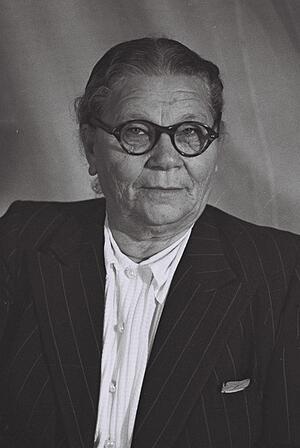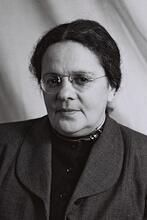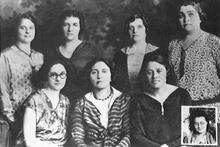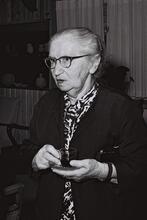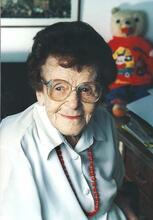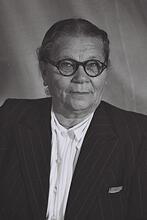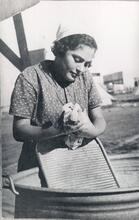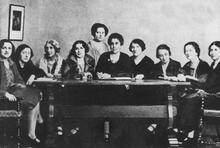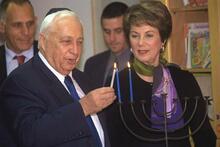Mo'ezet Ha-Po'alot (Council of Women Workers)
Protesting minimal representation in the foremost workers’ organization in pre-state Palestine, women activists called on the Histadrut to form an elected group for women workers and their interests. It was called the Mo’ezet Ha-Poalot (Council of Women Workers), and though it vied repeatedly for independence, the Histadrut was determined for it to remain under its wing. For this reason, Mo’ezet Ha-Poalot came to represent the interests of both women workers and the wives of Histadrut members, who may not have been in the workforce but were the majority of Histadrut women. The council balanced such activities as the pursuit of suffrage and equality, including in political office; training women in urban-industrial and rural-agricultural fields; and managing a corps of volunteers and welfare organizations.
Introduction
Founded in 1921 following the establishment of the Histadrut (General Federation of Workers), the Mo’ezet ha-Po’alot (Council of Women Workers) was formed to be the elected apparatus of Histadrut women, subordinated to the executive committee of the Histadrut, Va’ad ha-Po’el. It was founded by a small group of women who immigrated to Palestine at the beginning of the twentieth century.
The legendary leader of these women workers was Ada Maimon (Fishman), sister of Rabbi Judah Leib Maimon (1875–1962) of Jerusalem, a key figure in the Mizrachi religious-Zionist party. A zealous member of the Zionist workers party Ha-Po’el ha-Zai’r, Maimon devoted herself to the feminist cause and to improving the status of working women. As soon as the Histadrut was founded in 1920, Maimon became immersed in its activities, serving on the executive committee (Ha-Va’ad ha-Po’el) in the early 1920s, as well as on various other committees and in other departments. Of the many activities in which Maimon engaged during her lifetime, the one for which she became best known was the founding of the Council of Women Workers. In protest against denying women workers their own representation in the Histadrut, Maimon forced the newly elected leadership to acknowledge the new organization of women workers she helped create and to grant women an independent, yet affiliated, status within the Histadrut.
Women who joined the Histadrut became members of this special “women’s department” in one of two ways: by choice or automatically. The vast majority were either recruited or annexed to the Histadrut involuntarily. The largest category of automatic annexation was that of wives of Histadrut members. Mo’ezet ha-Po’alot was thus confronted with an inherent contradiction that had ramifications both for its activists and for rank-and-file members. On the one hand, its activists had to protect the interests of women wage earners, married or not. On the other hand, leaders of Mo’ezet ha-Po’alot had to meet the requirements of the vast majority of Histadrut women, stay-at-home mothers with families, who did not officially participate in the labor force.
During the late 1920s and the 1930s a few organizational and structural changes occurred within Mo’ezet ha-Po’alot. Among these changes, which reflected the priorities and currents prevailing in the Histadrut, was the formation in 1934 of a new women’s body: Irgun Immahot Ovedot be-Meshek Beitan (The Organization of Work-At-Home Mothers). In 1937 a new local council of women workers, Ha-Mo’azah ha-Ironit le-Inyenei Po’alot, was founded in the big cities, Tel Aviv, Haifa, and Jerusalem. In 1976 Mo’ezet ha-Po’alot changed its name to Na’amat, The Movement of Working Women and Volunteers, which today enjoys a membership of over three hundred thousand women in Israel and around the world.
High Hopes, Lowered Expectations: Founding Mo’ezet Ha Po’alot
The founding of a special women’s institution within the Histadrut was the deed solely of women workers. In December 1920, at a convention aimed at creating a new organization for Jewish workers in Palestine, Ada Maimon protested against the poor representation of women. Of the thirty women who were present on this festive occasion and who were relegated to passive participation, not a single one was elected by her women peers to represent the women workers.
At the closing session, Maimon threatened to marshal an election war against the newly-born Histadrut if the elected committee were to deny women workers the right to choose their own representatives or to bar these representatives from participating in the committee. Fearing the consequences, the newly elected leadership of the Histadrut had to reconcile themselves to the demand and the rivals started negotiating the terms. The resolution agreed upon enabled women workers to elect a new women’s council that would be allowed to select two female representatives to the central committee of the Histadrut. Maimon’s demand was thus converted, not for the last time, into a more moderate form of female operation.
Maimon expressed the ongoing dissatisfaction and disappointment of a group of veteran working women who participated in the pioneering enterprise before World War I. These women protested against the leadership of the Zionist Labor Movement who failed to meet women’s expectations of becoming equal partners in the emerging new society. Maimon and a few other women workers transformed this protest into a social movement that aimed to secure women’s interests within the general workers’ organizations.
Pragmatism and compromise enabled both the women workers and the leadership of the Histadrut to establish an autonomous—yet affiliated—women’s council. Accepting an affiliated female organization was intended on the one hand to neutralize the lethal potential of future claims to independence on the part of the workers, while on the other hand making sure that women would be kept under control. Yet this spirit of concession also underlines the fact that Histadrut women had to retreat from their radical ideals and to settle for less, both in terms of equality and of independence.
Goals of Operation
The elected organization of the Women Workers Movement and Mo’ezet ha-Po’alot did not chart any official set of goals. Nevertheless, in 1931, a decade after the Council of Women Workers was established, a brief set of regulations was published under the auspices of the Histadrut executive committee and with its approval. The declaration, entitled “Regulations of the Council of Women Workers of the Histadrut, 1931,” delineated the goals of the women’s apparatus as follows:
[We will] educate women workers in The Land of IsraelErez Israel in agriculture and train them to perform various urban and non-urban occupations. [We will] establish cooperatives and workshops for women workers and will assist working mothers by creating accommodation for children. [We will propagate] cultural and educational activity among women workers. In order to achieve these goals, the association of women workers is entitled to negotiate with other associations and institutions.
This concise definition conceals the actual spectrum of activity endorsed by Mo’ezet ha-Po’alot; throughout their many years of activity, the women activists in fact manifested a much broader definition. Mo’ezet ha-Po’alot aimed to mold a “new woman” in contrast to the traditional, undereducated, dependent woman of the past; the woman worker was considered an independent human being who, like her male counterpart, was entitled to enjoy equality of rights and duties. As feminists, leaders of Mo’ezet ha-Po’alot did not reject the existence of biological differences between the sexes, but they rejected their social and economic implications.
Ending the historic discrimination against women in all aspects of life was another goal. To accomplish this, activists of Mo’ezet ha-Po’alot avowed, women should be socially and politically educated. Political savvy and training would empower women and thus prepare them for their new role as partners in the Zionist-Socialist endeavor. Hence collaborating with the Histadrut, which had political as well as economic clout, was pivotal in Mo’ezet ha-Po’alot’s plan to produce a new type of woman. Did the affiliation with the Histadrut benefit women?
Affiliation and Subordination: Mo’ezet Ha Po’alot and the Leadership of the Histadrut
Relations between Mo’ezet ha-Po’alot and the Histadrut’s leadership were shaped by three main issues: affiliation or non-affiliation; assimilation or integration, i.e., autonomy for women workers’ institutions or their subordination to the larger Histadrut institutions; and the relations between the center and the periphery in the women workers’ movement itself.
Activists of Mo’ezet ha-Po’alot declared their nonpartisan, autonomous affiliation with the Histadrut, but this declaration of affiliation did not grant Mo’ezet ha-Po’alot an equal status within the hierarchy of the Labor Movement and the subordination of the female apparatus in the Histadrut was pronounced. The inferior status of Mo’ezet ha-Po’alot to a great extent determined its ability to provide solutions for its constituency, as well as its ability to pave their way into power positions in the Histadrut and in society as a whole.
Women and men activists had a different interpretation and vision of the new women’s organization, which reflected inherent contradiction. Since the leaders of the Histadrut accepted the female organization as a compromise, a result of their failure to solve gender conflicts, they strove to control and restrict Mo’ezet ha-Po’alot. On the other hand, for activists like Maimon, the new organization was a potent tool aimed at enlarging the organization’s scope of activity and independence for the entire duration of its existence. The length of time this female organization should be active was as long as there was a need for women to take responsibility for their unique problems, i.e., for a very long time indeed!
Budgetary problems are one example of women’s self-initiative; defying attempts to interfere with the process of nominating representatives to the secretariat of Mo’ezet ha-Po’alot is another. An analysis of the budgetary structure of the Council of Women Workers highlights the discriminatory policies of the Histadrut executive committee. The continuing refusal to fund the female apparatus marginalized women and imperiled their efforts to gain independence. Funding from other Histadrut institutions such as the Agricultural Center (Ha-Merkaz ha-Hakla’i) or from the various Zionist institutions was also insufficient for the needs of the women.
Mo’ezet ha-Po’alot cooperated with other women’s organizations, both socialist and middle class. WIZO, the Women’s International Zionist Organization, was among the latter. The main source of funding for Mo’ezet ha-Po’alot came from the Pioneer Women in the United States; the Pioneer Women’s funding comprised 96 percent of Mo’ezet ha-Po’alot’s budget in 1932 and 55 percent in 1939. In the 1930s WIZO’s contribution to Ha-Merkaz ha-Hakla’I, Mo’ezet ha-Po’alot’s agricultural farms, was also well defined. WIZO’s share ranged from 49.9 percent of its own total annual expenses in Palestine in 1931–1932 to 23.8 percent, the lowest rate, in 1935–1936, and to 37.1 percent in 1939–1940. These independent sources engendered a bitter rivalry between all the parties concerned. In the 1930s the Histadrut executive committee finally resolved that the funds would be distributed among Mo’ezet ha-Po’alot and Ha-Merkaz ha-Hakla’i for the use of women’s agricultural centers only.
Another means of improving Mo’ezet ha-Po’alot’s budgetary viability was a new membership tax imposed on Histadrut women. The membership fee had two main functions: to transform passive women members into more active members; and further, to find alternate sources of funding to that contributed by the Pioneer Women, which was hard hit by the economic depression in America at the beginning of the 1930s. Collection of this fee commenced at the end of the decade, but at that stage it did not fulfill the hopes pinned on it.
This gendered tax indicates the ambivalence of the Histadrut vis-à-vis its women members. Women ignited, marshaled and supervised the new campaign. Yet various Histadrut institutions claimed a share of the income. After a long debate, the leadership of the Histadrut resolved that the total sum of the tax income should be remitted to the executive committee, which would deduct its share of the money (twenty percent) and would then distribute the balance of the sum between the local workers’ councils, for the use of Histadrut women only, and to Mo’ezet ha-Po’alot. Thus almost two decades of economic dismissal came to an end and Mo’ezet ha-Po’alot gained some financial independence.
Interfering with the process of nominating representatives to Mo’ezet ha-Po’alot, and the struggles between the male and female apparati to restructure it, raise the question of boundaries and dominance of female institutions in a male-dominated environment. Such a struggle can be exemplified by Golda Meir’s meteoric rise in the Jewish community in Palestine prior to the establishment of the State of Israel. "Old Yishuv" refers to the Jewish community prior to 1882; "New Yishuv" to that following 1882.Yishuv political arena. In 1922, soon after her arrival in Palestine, Meir participated as a delegate in the women workers’ second convention in Haifa and was elected to Mo’ezet ha-Po’alot. Until 1925 the elected Mo’ezet ha-Po’alot was unable to assert its authority and its work was constantly interrupted. As a result, the executive committee nominated another female workers’ committee, in which Meir did not participate. A few years later, in 1928, she accepted the offer of David Remez (1886–1951), a key figure in the executive committee, that she become a member of the secretariat of Mo’ezet ha-Po’alot.
Launching Golda Meir to this top position gave her precedence over colleagues and rivals in the most important position in the organization, and at the same time ensured that the interests of the male leadership of the Histadrut and of her party, Ahdut ha-Avodah, were well taken care of. By nominating Meir, the leaders of Ahdut ha-Avodah could conceal their real motives: defeating the fearless opposition led by Ada Maimon and her loyal devotees of Ha-Po’el ha-Za’ir, the rival party, who frequently challenged the leadership of the Histadrut. From the male leadership’s point of view, an obedient candidate like Golda Meir, with no apparent feminist aspirations or feminist agenda, was undoubtedly the best nomination they could hope for.
The time Golda Meir served in the secretariat was often interrupted by her frequent trips to Europe and the United States. During her absences, a bitter rivalry overshadowed the relationship between the remaining activists, and this did not subside even after Golda Meir returned. In January 1930, after a year and a half full of intrigues and turmoil in the secretariat, Golda Meir decided to resign. For years to come Ada Maimon remained the undoubted leader of the women workers’ movement. In 1931, however, another staunch activist rose to power in Mo’ezet ha-Po’alot; this time, it was a member of Mapai, the ruling party—Beba Idelson. Her position in the secretariat was unchallenged and she retained office for many decades until her resignation in 1974.
Similarly, the creation of a parallel female hierarchy within the Histadrut was the source of bitter debates and conflicts. Systematically ignoring the plight of the female workers and their struggle to survive amid economic turmoil, the members of the Histradrut executive committee, especially members of Ahdut ha-Avodah, were greatly opposed to any sign of independence.
From 1925 on, the maneuvers conducted by members of Mo’ezet ha-Po’alot to create local branches for women workers yielded no significant results. In 1927, the leaders of the Histadrut were determined to create the planned new female institutions, and by doing so to keep the women under control. Only at the end of 1934 was the longed-for entente between the representatives of Mo’ezet ha-Po’alot and the representatives of the Histadrut’s local branches agreed upon. At the beginning of 1936, after more than a decade of misery and distraction, a decision was taken to start organizing the vital institutions. In 1937 the local municipal Council of Women Workers, Ha-Mo’atzah ha-Ironit le-Inyenei Po’alot, was finally established and its activities, albeit small in scale, started in Tel Aviv, Haifa, and Jerusalem.
Spectrum of Activity
Devar ha-Po’elet: A Vehicle for Women’s Empowerment
Mo’ezet ha-Po’alot aimed at expanding women’s boundaries and traditional roles in general and in the labor force in particular. Empowering women by means of education and training was no less important. Thus in 1934, after a tedious campaign, Mo’ezet ha-Po’alot launched its own journal, Devar ha-Po’elet, under the auspices of Davar, the Histadrut’s daily newspaper. Devar ha-Po’elet, the only Jewish women’s journal in the 1930s, served as a vehicle and a platform for Histadrut women. Under the guidance of Rahel Katzenelson, its long-time devoted editor, women’s voices resonated vigorously. Women expressed their problems, shared experiences, advised, educated, and consoled others. In 1976 Devar ha-Po’elet changed its name to Na’amat, with Zvia Cohen as its editor.
Suffrage and the Pursuit of Gender Equality
Activists of Mo’ezet ha-Po’alot initiated, furthered, and achieved (although not in full) the principle of women’s equal rights in the Yishuv. Between the years 1917–1926 a struggle for the right of women to elect and to be elected to the emerging political institutions was central to the national agenda. In 1927, as a result of the united front presented by the women regardless of their political affiliation, this struggle was victoriously concluded when determined Jewish women in Palestine gained the right to vote and to be elected to political office.
An initiative of the united front of women’s organizations to form a Bet Mishpat Ivri Hiloni (secular Hebrew court), a civil court where marriages and divorces would be dealt with, was not realized, and the longed-for legal equality between men and women seemed lost. Nevertheless, Mo’ezet ha-Po’alot did not loosen its grip; when another legal campaign loomed, the organization’s activists engaged in it, this time successfully. In 1934, following a long debate, activists of Mo’ezet ha-Po’alot forced the Jewish National Fund to accept the principle of joint ownership of property for both husband and wife.
Similarly, both men’s and women’s right to serve in the military was agreed upon, first during World War II and again after the state of Israel was founded. During the first years of statehood Ada Maimon and others campaigned for additional equal rights. As a result, one of the country’s new laws defined seventeen as the legal age of marriage, while another outlawed bigamy.
Welfare and Social Activity
Mo’ezet ha-Po’alot also acted on behalf of women in other arenas. It engaged in crucial social issues via its welfare organization, Irgun Immahot Ovedot be-Meshek Beitan. The influx of immigrants to pre-state Palestine and later to Israel confronted the Yishuv with an unprecedented magnitude of problems, from housing, health, employment, and training to marital and other family concerns. Women volunteers (mostly stay-at-home mothers and wives) partook in the task of assisting the immigrants, seeking ways to ease their integration into the new society. The women volunteers immersed themselves in other activities as well. They created an infrastructure of kindergartens, clubs, and shelters for children in the big cities and the Lit. "village." The dominant pioneer settlement type of the Jews in Palestine between 1882moshavot; educated and trained working mothers and stay-at-home mothers alike; and inculcated skills of efficient home management and means to earn extra money that were crucial during times of economic hardship.
The Labor Force—Employment and Training
Women’s employment was indeed a major area of activity advanced by the women workers’ movement, since place of residence and mode of employment dictated different realities of life for women and also defined the boundaries between women and men. Women workers endured more unemployment than men and suffered more from its side effects. Their wages were low and inadequate, making it impossible for them to cover their living expenses. Women’s medical care, if they were entitled to any, was only partial, despite the fact that their needs were generally greater than those of men. An understanding of this social complexity is a prerequisite for an evaluation of the operations of Mo’ezet ha-Po’alot.
The extent and limitations of the authority of Mo’ezet ha-Po’alot in the labor market explain the absence of practical differences between working women who were members of the Histadrut and those who were not. A primary and central factor was the preemption of authority to deal with women wage earners. The various institutions of the Histadrut, from the local workers’ councils to the trade unions, were in charge of this. Preemption of the female organization’s authority over working women nullified its ability to exert influence through the provision of employment.
Severe disagreements emerged among the members of Mo’ezet ha-Po’alot concerning the question of which areas of operation were desirable. One such argument turned on the centrality of agriculture. The crowning jewel was women’s farming projects, the premise of which was to provide women workers with both professional training and employment, especially during ebbs in the economy. Zionist ideology regarded agriculture as redemption, and this was joined to practical considerations. The focus on agricultural initiatives, however, did not solve the problems of the bulk of women workers. The vast majority of women did not wish to live in the rural sector of the country, nor did they want to become agricultural workers. Most immigrants, men and women alike, chose the cities as their ultimate destination and were in need of different guidance and training. Despite massive efforts, in 1930 the six farms (Meshek ha-Po’alot) all over the country, from Afulah to Jerusalem, Petah Tikvah and other places, had only 390 members, of whom 38 found a way to resettle in the city. These data highlight the fact that Meshek ha-Po’alot was indeed a solution suited only to the few.
Programs designed for urban women had equally bleak outcomes. Among these programs were the cooperatives of women workers (Havurot) and the industrial cooperatives. In the years 1926–1927 eleven Havurot were founded, five in the cities and six in the big moshavot, the rural non-collective colonies. The Havurot, engaged in agriculture and other seasonal occupations, constituted a new form of activity based on the existing collective mode of life, whereby a group of women shared living, training, and working together. Each Havurah managed itself via an elected committee. Emphasis was put on managerial skills as well as on socialist and Zionist values. At the end of the training process, the graduate was to be transformed into a self-sufficient, independent, and skilled worker. In the long run, the Havurot did not live up to expectations. In 1926 the membership totaled 250, and in 1929 there were only 130 members. At that time, six of the Havurot were shut down, and in the next year only four Havurot remained, with a total of 67 members, all of them in Tel Aviv and the vicinity. The failure of the Havurot derived from a combination of factors, mainly the lack of suitability of these solutions for the majority of women workers, who did not aspire to live cooperatively or to work in agriculture. During the 1930s, with the expansion of alternative employment opportunities in the cities, women left these programs. Towards the end of this decade the farms were gradually converted into boarding schools for native-born and new immigrant girls.
Industrial cooperatives were founded in the 1920s and in the 1930s, mostly in traditional women’s occupations such as cooking, sewing, laundry and light manufacture, such as furniture or shoe making. The cooperatives were regarded as a fairly easy solution for women’s unemployment. As such, they had to be connected to the workers’ main centers. In the late 1930s eleven cooperatives in the big cities and moshavot employed 84 women. Like the Havurot, the cooperatives to some extent succeeded in aiding women workers by rescuing them from unemployment and harsh living conditions. Yet they did not become an economic solution for the mass of urban working women. The attempt to serve different and sometimes opposing sectors—urban-industrial, agricultural-cooperative and others—was doomed to failure.
The attempt at cooperation met with severe criticism both from within the women workers’ movement and from without. A growing critical urban-based opposition was backed by the leftist parties of the Yishuv. Together, they exploited every available opportunity to attack the women functionaries of the Histadrut for their excessive focus on agriculture, their lack of understanding of the needs of the urban constituency of working women and their capitulation to the institutions of the Histadrut.
Conclusion
In the struggle between the forces of conservatism in the Histadrut, represented by members of the establishment, and the forces of innovation, represented by the members of the women workers’ movement, the former almost always predominated. The women who belonged to the Histadrut, like all women, seldom succeeded in deviating from the traditional women’s roles and duties apportioned to them. The marginality of the Council of Women Workers in the Histadrut establishment and the relative powerlessness of the constituency of working women in the Yishuv labor market brought about the transition from a movement in which working women occupied the center of the movement (as was the case in the 1920s) to a movement in which wives of Histadrut members, nearly all homemakers, became a principal force; from a movement striving for independence, to an institutional arm of collaboration, with a field of operation anchored in the tradition of women’s volunteer work.
Nevertheless, the movement, via its local chapters, lost no opportunity to inject the special concerns of women, working women, and homemakers alike, into the public agenda. This effort was made on two principal planes: publicizing the special problems of the woman worker in the labor market, as well as those of the mother working in her home; and searching for ways, some quite novel, to solve these problems. In terms of the period under discussion, even the little that was accomplished was a great deal.
Na’amat
In 1976 Mo’ezet Ha-Po’a lot changed its name to Na’amat, The Movement of Working Momen and Volunteers. Na’amat is subordinated to the Va’ada Merakezet, the central apparatus of the Histadrut. The organization includes Jewish, Arab, and Druse women, from urban as well as agricultural centers. Na’amat also includes all the overseas Pioneer Women groups.
Since the 1970s Na’amat’s proclaimed goals have been changed somewhat. They now comprise not only the improvement of women’s working conditions and ensuring their rights, but also expanded political education and the encouragement of volunteerism.
The organizational structure of the movement has not changed significantly. The women’s convention has remained the basic forum for Histadrut women to elect their representatives and the council remains the forum which deals with the movement’s policies. As in the past, an active secretariat presides over the other bodies and is in charge of all Na’amat activities. Its representatives report to the Histadrut’s management. Na’amat’s local branches are under the supervision of those of the Histadrut.
For several decades Na’amat has been active in areas of women’s equality, collaborating with members of the Lit. "assembly." The 120-member parliament of the State of Israel.Knesset in initiating or advancing laws on abortion, widows’ rights, social rights for homemakers, and more. Na’amat also provides legal assistance to women and operates kindergartens and after-school social and educational activities for women and their children. As in the early period of statehood, Na’amat helps new immigrants and their families in the absorption centers. Na’amat also strives to advance young, unmarried women. Aware of the centrality of the military in Israeli society, its activists refuse to accept any changes in the draft or in the status of women soldiers that might impair women’s chances of attaining equality. Devar ha-Po’elet, the magazine of the former Mo’ezet Ha-Po’a lot, has changed its name and become Na’amat Monthly.
Bernstein, Deborah S. The Struggle for Equality: Urban Women Workers in Prestate Israeli Society. New York: Praeger, 1986.
Izraeli, Dafna N. “The Women Workers’ Movement: First-Wave Feminism in Pre-State Israel 1919–1939.” In Pioneers and Homemakers: Jewish Women in Pre-State Israel, edited by Deborah S. Bernstein, 183-210. Albany: State University of New York Press, 1992
Maimon, Ada Fishman. Hamishim shenot tenu’at ha-po ‘alot, 1904-1954 (Fifty Years of the Women Workers’ Movement, 1904–1954). Tel Aviv: Ayanot, 1955.
Meir, Golda. My Life. New York: G.P. Putnam’s Sons, 1975.
Melman, Billie. “‘Angelus Novus’: Women’s-History, History and Politics 1880–1993” (Hebrew). Zemanim 46–47 (Winter 1993): 19–33
Scott, Joan Wallach. “On Language, Gender and Working-Class History.” In Gender and the Politics of History. New York: Columbia University Press, 1988, 53–67.
Shepherd, Naomi. A Price Below Rubies: Jewish Women as Rebels and Radicals. Cambridge: Harvard University Press, 1993.
Stern, Bat-Sheva Margalit. “The Women Workers’ Movement in Pre-State Israel: The Council of Women Workers 1920–1939” (Hebrew). Unpublished Ph.D. diss., Haifa University, 1997
Stern, Bat-Sheva Margalit. “Between Female and Male Dominance: The Women Workers Movement in Erez Israel” (Hebrew). In Ha-‘Ivriyot ha-hadashot: nashim ba-yishuv uva-Tziyonut bi-rei ha-migdar (Jewish Women in the Yishuv and Zionism: A Gender Perspective), edited by Margalit Shilo, Ruth Kark, and Galit-Hasan Rokem, 292–314. Jerusalem: Yad Yitzhak Ben Zvi, 2001.

